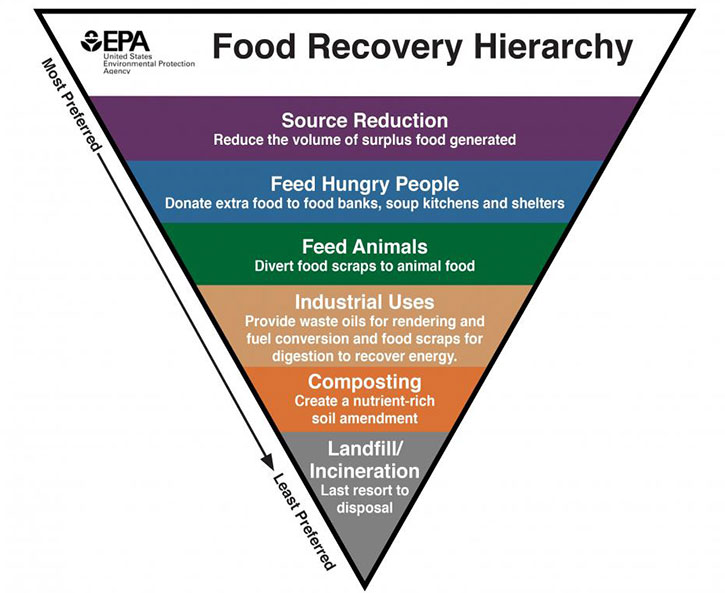
Food waste: Everything you and your office needs to know
posted on
In November 2019, Mother Jones published the article Tech Company Free Meals Beget a Lot of Leftovers. Meet the Man on a Mission to Rescue Them. This article, written by Marisa Endicott, accompanies Eating in Climate Chaos a special series podcast from Bite, called ‘The Leftovers.’ This collaboration piece is an excellent reminder of the ever-present and serious issue of food waste, which we will discuss in-depth now.
Just how big is the issue of food waste? Today, you’ll find out as we take a look at:
- 11 of the most shocking food waste facts
- How Food Runners is helping divert local food waste from offices to those in need
- The problem of overabundance and consumption
- Rethinking our consumption and waste cycles
- How Foodee tackles food waste in offices across North America
The worst offenders: 11 top food waste facts you should know
- Every year, 1.4 billion tonnes of food—1/3 of global food production—ends up in landfills (source: Bloomberg).
- Food waste costs $1 trillion annually (source: Bloomberg).
- Food waste produces 8% of all human-caused greenhouse gases and contributes to climate change (source: Project Drawdown).
- Almost 800 million people go hungry every day (source: Bloomberg).
- The U.S. wastes about 40% of its food supply every year (source: NDRC Food Waste report 2017).
- Americans waste 400 pounds of food per person every year. This collectively costs up to $218 billion annually (or 1.3% of the GDP) (source: NDRC Food Waste report 2017).
- If 50% of food waste is reduced by 2050, we would avoid 26.2 gigatons of carbon dioxide emissions (source: Project Drawdown).
- Up to 35% of food in high-income economies is thrown out by consumers. Relatively little is wasted among low-income economies (source: Project Drawdown).
- Reducing waste avoids the deforestation for additional farmland and prevents 44.4 gigatons of additional emissions (source: Project Drawdown).
- In 2017, over 40 million people had food insecurity (or lack of access to enough food) in the U.S. (source: Feeding America Org).
- In the U.S., about 43% of all food waste is by consumers at home—68% of what is thrown out is edible (source: Bloomberg).
Diverting office food waste from landfills to those in need
Less than one-third of the food that we throw into the landfills would be enough to feed 42 million Americans without access to food. This is already happening but it’s still not enough. Bloomberg recently wrote on how food waste startups have raised more than $125 million in capital to improve food efficiency, however, the difficult part is convincing consumers not to throw away good food (we’ll get to that shortly).
Mother Jones interviewed Les Tso from Food Runners, a San Fransisco-based non-profit that diverts leftovers from tech companies and businesses and drops them off at organizations that give food to people in need. Tso picks up dozens of trays of leftovers from about 16 different companies daily (80-90 weekly) and delivers them to shelters, churches, charities, and low-income houses. They collect over 17 tonnes of food in San Francisco, enough to serve over 20,000 meals a week.
“I think everyone who does this is incredulous about how much there is,” Tso explained to Mother Jones. “It’s just crazy. And I’m only seeing the tip of the iceberg.”
Overconsumption at home, in stores and in the office
“There’s going to be food waste anyway because of the way that our economies, businesses, and mindsets are,” Tso explained. “That could easily get better. But, I think, people just don’t value food and the preciousness of it. Everyone expects free food at work and it’s hard because if the company runs out, that’s bad, so if you can’t run out of food, you have to over order.”
Herein lies the crux of the problem. High- and middle-income earners are blessed with a false sense of overabundance both in our homes, in grocery stores, at restaurants, and, most recently, in our offices. But just because (top tech) companies offer free meals at work, shouldn’t equal direct food waste.
For example, Google began to track food waste and consumption. In just five years, it saved 6 million pounds of food. Despite this, Tso explained that he still leaves extra room for Google’s leftover deliveries every day.
Rethinking our consumption and waste cycles
Mother Jones and Bite podcast also spoke to Andrea Collins, a sustainable food systems specialist at the Natural Resources Defense Council (NRDC). “Stopping waste by making sure our farms don’t overproduce and we don’t buy or cook more food than we can eat is the most important thing we can do to tackle our food waste problem,” she told them. After that, feeding hungry people is a top priority.
It’s also about rethinking what we buy, consume and throw out.
“There’s gold in keeping bananas yellow,” opened Deena Shanker in her 2019 Bloomberg article on the trillion-dollar problem of food waste.
She couldn’t have been more correct in more ways than she intended. Why do we feel the need to pack our fridges with only the most beautiful produce when we will likely throw half of it out weeks later? Trader Joe’s once gave Tso from Food Runners 26 cases of bananas because of their mandate to not sell the ones with brown spots (ie. the ripe ones).
When it comes to office catering, why do we feel the need to over-order food and how can we break this wasteful cycle?
How Foodee tackles food waste in offices across North America
Andrea Collins said that “workplace cafeterias can be an amazing place to make a big amount of change because you’re serving a lot of food all at once. I think that’s actually a potential place where change can happen pretty quickly.”
We agree. Offering free food at work should be a good perk—both for you, your company, community and planet. It shouldn’t be wasteful or environmentally destructive, adding to climate change with increased emissions and deforestation, or leading to more hunger.
At Foodee, we believe in following environmentally-friendly practices such as supporting local owner-operated restaurants only, reducing our carbon footprint with less transportation and using compostable and biodegradable packaging and utensils wherever available. Our individual ordering and portion size options help us work with local kitchens, farmers and offices to reduce food waste.
Individuals at companies with 10 to over 500 employees order exactly what they want to eat from their favourite local restaurants on days that they intend to eat at the office. Meals are delivered in sustainable individual packaging and labelled for that person. This option encourages employees to alter their habits slightly but makes a huge impact on reducing food waste. Companies shouldn’t have to order double the amount of food for a guesstimated amount of employees every day. Why don’t we train ourselves to order the right amount instead?
It may sound (laughably) groundbreaking. But it really only takes a subtle change in how we buy and order food to make a dent in reducing food waste. Remember, 68% of food that is thrown out by consumers was perfectly, deliciously edible in the first place.
Filed Under: Foodee HQ


